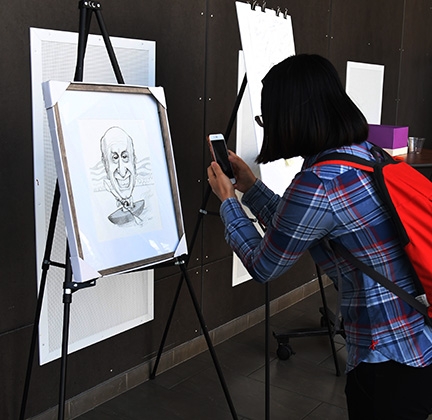
The distinguished professor, known for his expertise in chemistry, toxicology, biochemistry and entomology, meshes all four sciences in his 50-year research on acute and neuropathic pain in humans and companion animals. It all began with his basic research on how caterpillars become butterflies, research that led to key discoveries about chronic pain.
But back to the reunion.
illed as “Biochemistry and Society: Celebrating the Career of Professor Bruce Hammock,” the three-day event drew Hammock lab alumni from throughout the United States, as well as Egypt, Spain, China, Australia, New Zealand, Germany, Sweden, Canada and the Czech Republic.
“It was really special and I will treasure that weekend always,” said Hammock, who trained scientists at UC Riverside for five years before joining the UC Davis faculty in 1980. He currently holds a joint appointment with the UC Davis Department of Entomology and Nematology and the UC Davis Comprehensive Cancer Center. He has directed the UC Davis Superfund Program, funded by the National Institutes of Health's National Institute of Environmental Health (NIH/NIEHS), for 31 years.
Hammock's colleagues, and former postdoctoral fellows, graduate and undergraduate students and visiting scholars arrived at the lab reunion with their spouses--as well as their scientific posters for display and discussion. The posters covered everything from ground-breaking research in prestigious journals to a humorous look at his annual water balloon battles in front of Briggs Hall.
The scientists dined at the UC Davis Conference Center, the Buehler Alumni Center and the Stonegate Country Club; shared months, years and decades of memories; and toasted, roasted and gifted their mentor. Hammock, in turn, toasted, roasted and gifted them.
“We had a blast,” recalled organizer Shirley Gee, a former research toxicologist and manager of the Hammock lab for 31 years. She retired in June 2016 after 40 years of service with the university.
“I have had a vision of this event to honor Bruce for many years now, and it was such a thrill to see it come together,” she said. “Reconnecting in person with all the alumni and their families was more rewarding than I could have imagined, but even more importantly was the thrill of watching alumni reconnect with each other! There were a lot of tears in the house. Many people I think were surprised by how the years melted away when they began reacquainting. I think that speaks to the environment that Bruce created that led to many strong personal and professional bonds.”
Gee credited her seven-member committee—former Hammock students Keith Wing, Jim Ottea, Tom Sparks, Babak Borhan, Qing Li; postdoctoral fellow and “academic grandson” Kin Sing Stephen Lee, a former student of Babak Borhan; and colleague Sarjeet Gill, now a distinguished professor at UC Riverside, with greatly contributing to the success of the one-of-a-kind celebration.
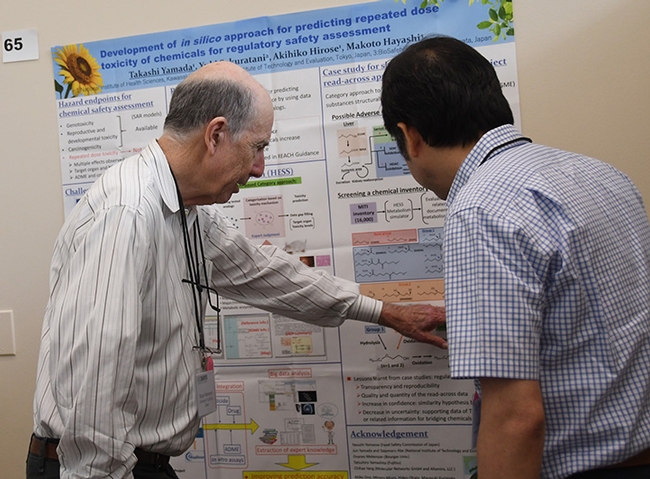
Hammock has studied the enzyme system and its inhibitors ever since. His lab has generated more than 80 patents, 300 postdoctoral fellows, and more than 65 graduates, who now hold positions of distinction in academia, industry and government. He recently formed a Davis-based company, EicOsis, to develop an orally active non-addictive drug for inflammatory and neuropathic pain for human beings and companion animals. Human clinical trials are scheduled to begin in 2019. Several seed-fund grants and a NIH/NINDS (National Institute of Neurological Disorders and Stroke) Blueprint Development Grant support EicOsis.
Hammock, described at the lab reunion as a “genius,” collaborates with scientists worldwide in what's been described as “unprecedented research with a multidisciplinary, integrated approach to research focused on insect biology, mammalian enzymology, and analytical chemistry.” He has authored more than 1000 publications on a wide range of topics in entomology, biochemistry, analytical and environmental chemistry in high quality journals, and has been cited more than 54,000 times. In the epoxide hydrolase field, the Hammock laboratory has published almost 900 peer-reviewed papers.
Tom Sparks, who was Hammock's first graduate student at UC Riverside, chronicled Hammock's career and recalled humorous anecdotes from his early professorship at UC Riverside. A former professor at Louisiana State University, and now a research fellow in Discovery Research at Dow AgroSciences (now Corteva Agriscience, Indianapolis, Sparks praised Hammock's intellect and curiosity. “For Bruce, it was all about the journey, looking around and operative at the interface between entomology, biochemistry and chemistry.”
Gill, along with University of Utah emeritus professor Glenn Prestwich and UC Davis research scientist Karen Wagner also delivered presentations, fondly recalling their shared time and science with Hammock.
Keith Wing, who was Hammock's second graduate student at UC Riverside/Davis, served as emcee at the lab reunion. A former senior research associate at DuPont and Rohm and Haas and current consultant, Wing said “Bruce has inspired many hundreds of developing scientists. For myself and many others, he was able to see what we could become as scientists and social contributors before we could see it ourselves."
Others commented that they learned this from Hammock: “We explore the unexpected and get to do things that don't work” and “Design things to fail; when they don't fail follow along.”
Hammock, the crowd agreed, seems to follow baseball legend Yogi Berra's sage advice: “If you come to a fork in the road, take it.”
Gill praised Hammock's “impact on human health, environmental health” as well as his love of the outdoors—from kayaking to mountain climbing.
Numerous alumni lauded Hammock's sense of humor. One scientist quoted Albert Einstein as saying “Creativity is intelligence having fun” and added “Bruce is always having fun.”
Among the other comments:
- “I never heard him speak a cross word.”
- "He treats everyone with respect.”
- "Bruce loves science and he loves people.”
- "He never heard a crazy idea.”
- "What Bruce does—he delivers the future.”
- "Bruce has a lot of determination and can approach difficult problems from multiple angles.”
- "Bruce values strong relationships with friends he has made over the years”
A native of Little Rock, Ark., Hammock received his bachelor of science degree, magna cum laude, in 1969 from Louisiana State University, Baton Rouge, where he majored in entomology and minored in zoology and chemistry. Then it was off to UC Berkeley, for his doctorate in entomology/toxicology in 1973, and postdoctoral fellowship.
It was at UC Berkeley where he met and married his wife, Lassie, who had just entered the doctoral program in plant physiology. They married in 1972 and then “the Army called me up,” Hammock remembers.
Hammock served as a public health medical officer/first lieutenant with the U.S. Army Academy of Health Science in San Antonio, Texas; and then did more postdoctoral research at the Rockefeller Foundation, Department of Biology, Northwestern University, Evanston. Ill.
Hammock then joined the faculty of the Division of Toxicology and Physiology, UC Riverside Department of Entomology in 1975 before heading for UC Davis in 1980 to accept a joint-faculty appointment in toxicology and entomology.
Bruce and Lassie reared three children: Tom, Bruce and Frances. “Frances and her husband, Adrian, teach math at UC San Diego; Bruce is on the UC Davis School of Veterinary Medicine faculty; and Tom, a graduate of the American Film Institute Conservatory, makes movies,” Hammock said, adding that he and Lassie appeared in one of the movies that Tom directed: "The Last Survivors."
Highly honored by his peers, Hammock is a fellow of the National Academy of Inventors, which honors academic invention and encourages translations of inventions to benefit society. He is a member of the U.S. National Academy of Sciences, a fellow of the Entomological Society of America, and the recipient of scores of awards, including the Bernard B. Brodie Award in Drug Metabolism, sponsored by the America Society for Pharmacology and Experimental Therapeutics; and the first McGiff Memorial Awardee in Lipid Biochemistry.
Hammock told the crowd at the reunion that he began his career studying insect science but switched to human research after encountering “all the suffering involved in acute and neuropathic pain.”
His insect science research centered around how a key enzyme, epoxide hydrolase, degrades a caterpillar's juvenile hormone, leading to metamorphosis from the larval stage to the adult insect. He then wondered "Does the enzyme occur in plants? Does it occur in mammals?" It does, and particularly as a soluble epoxide hydrolase in mammals.
“It is always important to realize that the most significant translational science we do in the university is fundamental science,” said Hammock. “The extreme and poorly treated pain that I observed as a medical officer in a burn clinic in the Army, is a major driver for me to translate this knowledge to help patients with severe pain.”
And it all began with him asking how caterpillars turn into butterflies.
"Science is full of surprises," the distinguished UC Davis professor said. "We need to remember that the concept, the clinical target, and even the chemical structure came from asking how caterpillars turn into butterflies."
(See photos on the UC Davis Department of Entomology and Nematology news blog.)
Attached Images:
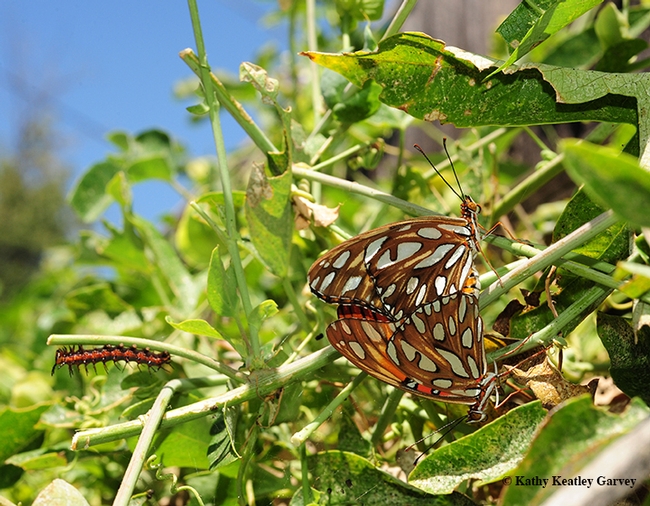
UC Davis distinguished professor Bruce Hammock's noted research on chronic pain all began at UC Berkeley when he wondered how caterpillars turn into butterflies. In this photo: two Gulf Fritillary butterfly mating, while a caterpillar munches passionflower leaves in the background. (Photo by Kathy Keatley Garvey)
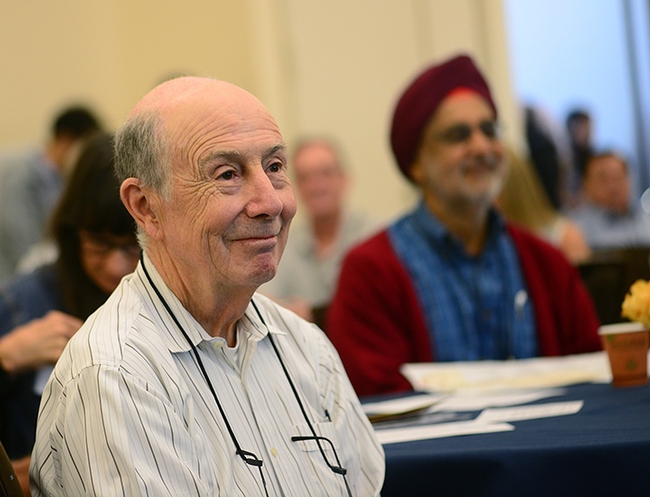
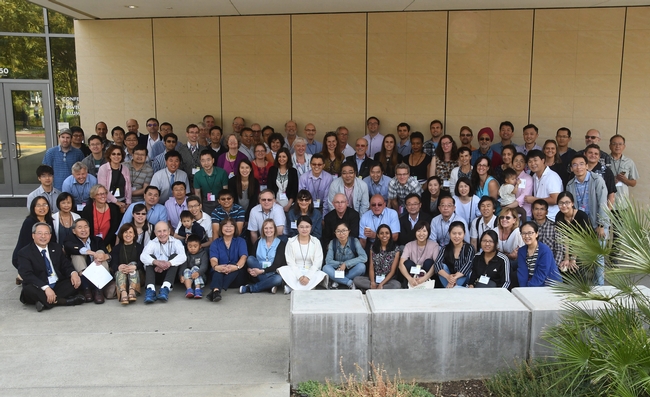
Some 100 scientists (and their families) from 10 different countries converged on the UC Davis campus to honor their mentor, Bruce Hammock. (Photo by Kathy Keatley Garvey)